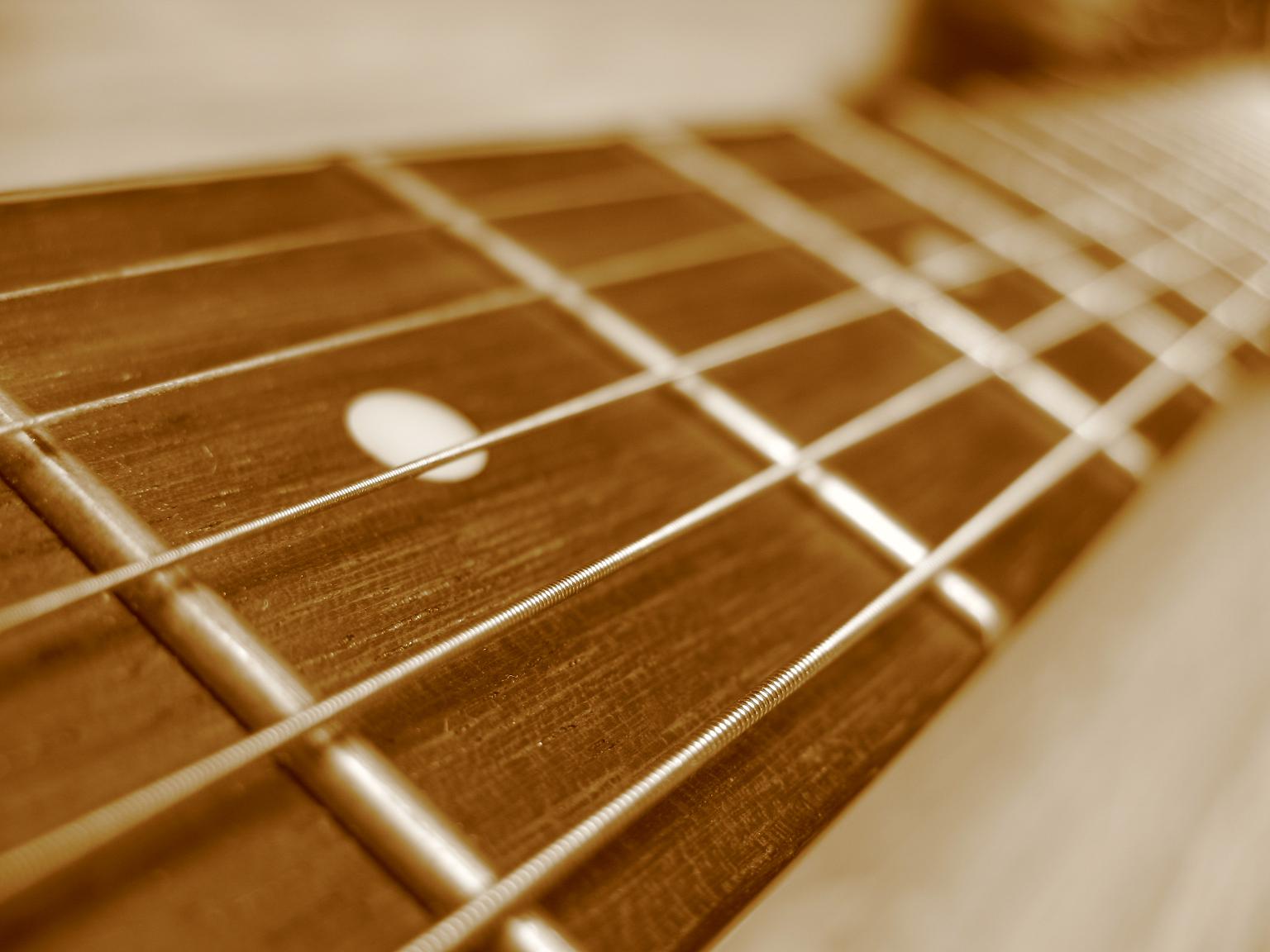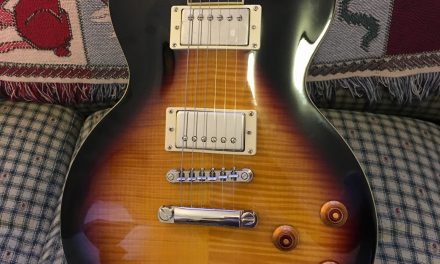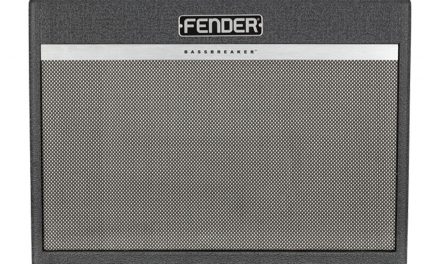(This post updated on Dec 29, 2022)
I’ve spent countless hours learning this stuff. And now I’ll summarize it in a simple list for my wonderful readers. Because you rock. You’ve got fret buzz? Let’s look at the list of culprits.
- Your technique.
- The Problem – No, really. One of the most common causes of fret buzz is how you strike the string with your pick. You should hold the pick at 90 degrees, perpendicular to the fretboard, meaning flat with the side of the string. If you pick a note with the pick at 90 degrees, the string is mostly vibrating sideways, parallel with the frets! If you rotate your pick to 35 or 45 degrees and pick downward, you’re vibrating the string up and… down, right into the metal fret. Buzzzzz. See footnote number one for speed metal picking disclaimer.
- The Fix – Change how you pick. Or at least be conscious of it.
- Action is too low.
- The Problem – If your action is too low, you will get fret buzz, period. What’s too low? That’s subjective, but here’s a tip: The only way to get really, really low action without buzz is to have a light touch and to have your guitar extremely well set up in terms of the straightness of the neck and the relief, the nut height, the string saddle heights, and having every fret at the exact same height and crowned perfectly. Your Squier Affinity Strat isn’t going to have all of those things coming out of the factory. Reasonable “low” action is 5/64th of an inch between the string and the 12th fret on the low E string, and 4/64th of an inch on the high E string. Lower than that and your guitar needs to be set up perfect first.
- The Fix – Check your action and raise it if it’s too low. If you insist on super low action, you’ll need to either take your guitar to a good repair person or learn all of the setup stuff yourself. I do recommend learning all of the setup stuff if you’re interested. It’s a whole other world, and for some people (like me) it’s a really fun world.
- Neck is bowed.
- The Problem – A guitar neck should be very close to straight. Some guitarists, like Jeff Beck, literally want their neck perfectly straight, but most players prefer a very slight bow in the neck. It helps reduce buzzing. This slight bow is called relief, because it’s a relief to have no buzzing. Actually it’s because you’re relieving a small amount of pressure on the neck. Anyway, if the relief is too small, you can hear buzzing and if it’s too big, you can hear buzzing. Most people agree the relief should be about .25 mm or .010 (or ten thousandths of an inch.)
- The Fix – A guitar has a truss rod, a metal rod embedded into the wood of the neck. You can access the truss rod under a cover in the headstock (usually.) An allen wrench can be used to turn the truss rod to the right (to make the neck straighter) or left (to loosen the rod and let more relief into the neck.) Put a capo on the first fret (or sucker a friend into fretting the low E on the first fret) and then press down on the last fret. Look for a small gap at the 8th fret. If the string is touching the fret, your neck has no relief. Best way to check is to use a .010 feeler gauge. If you don’t have a set, here’s a tip – a corner of a piece of paper should easily slide between the fret and the string at the 8th fret, but a credit card should be too thick to fit without pushing the string up. Go buy a set of feeler gauges. Just do it.
- Flat spots or divots.
- The Problem – The top of each guitar fret is like half a circle – the string only makes contact with the very top of the fret. Over time, frets can wear down and end up flat, or end up flat in the area where one string is. Bending notes can cause this to happen over time. If you look at your frets, you’ll see wear in the spots where you most frequently bend notes. A string can buzz if the top of a fret is too flat, or the top of a fret is too low.
- The Fix – If the buzz is very minor, you could decide to live with it. The fix is a level/crown, and it’s involved. You can learn how to do it yourself, but the odds are good that you’ll suck at it while you’re learning. If you’re not naturally gifted with tools, you might need to do 5 – 10 of these before you’ve got it down. You can take it to a shop and have it done. It should cost less than $150, unless the frets are too low.
- Extremely low (and maybe flat) frets.
- The Problem – Some guitars have “vintage” frets, meaning really small frets. When they wear down too far, you can’t really level/crown them, because there’s not enough fret to work with. Strings buzz on frets too low or too flat.
- The Fix – You need a complete refret. Depending where you live, that’s $150 to $200. Ouch! That’s a rip off, right? No, it isn’t. Refretting a guitar is a skill and it takes time to learn and perfect that skill. A really good luthier can refret your guitar and make it play better than it ever did before. And if you have a $3,000 Gibson Les Paul, $150 isn’t too much money to make it play awesome again. But if you’ve got a Squier Affinity Strat, you can buy a whole new guitar for about the cost of a refret. Or you can learn how to do your own fretwork. It takes about 50 refrets before you’re good enough to be able to charge money yourself and handle that Gibson Les Paul. But another option, IF you have a Strat or Tele, is to buy a new neck from Stratosphere. Stratosphere is a guitar parts seller who sells, well, guitar parts. You can buy a new neck for anything from an Affinity Strat to a Custom Shop Strat. A Standard Fender (made in Mexico) Strat neck will run around $200. Or the cost of a refret. Buy that neck for your Affinity Strat and you’ve made a massive upgrade. 🙂 Just don’t try to sell it as a Fender Strat, because that’s illegal and you’ll be a criminal. And a scumbag.
- Individual high frets.
- The Problem – It is possible, if your guitar is a piece of shit OR someone worked on it who didn’t know what they were doing, that you’re seeing a buzz because a fret is too high. Take a really flat credit card and put one of the edges of it down on the fret you think is high, so that the credit card is touching the high fret and the one on each side. If the fret is high, you can rock the credit card back and forth like a teeter totter.
- The Fix – Either take it to a repair person, or learn to do the repair yourself, because the fix is to file the fret down to the same level as its neighbors, then re-crown the fret, then polish it. If you do it wrong, you’ll create a new buzz.
- Nut is too low.
- The Problem – On a cheap guitar with a plastic nut, the strings cut grooves into the nut over time and the string height lowers. How do you know? If your action is reasonable and your relief is reasonable and your guitar is buzzing when you play open strings, it could be the nut is too low. Press down on the third fret and look at the distance between the string and the first fret. If it’s touching, your nut is too low.
- The Fix – It is possible to mix super glue with baking soda and fill in the slots in the nut for each string, then use fret files to set the height to your exact specs. Possible, and stupid. You need a new nut. Once again, either pay someone to do it or learn how. If you want to learn how, here’s a tip – don’t spend $80 on nut slot files. Buy a pre-cut Tusq nut and sand down the bottom until it’s the correct height and use that. You have to do it right or you’ll gooch it and create a new problem, but there are directions online in a million places.
- String Gauge Too Light.
- The Problem – Lighter gauge strings are easier to bend. Hooray! But they’re easier to bend because they require less tension, so they move around more, including bouncing off the tops of the frets.
- The Fix – Try moving from 9’s to 10’s and see what you think. Sometimes you just need 9’s, in which case you either need to play lighter or raise your action a little.
Disclaimer – Players who speed pick will sometimes angle their pick very slightly one way or the other to gain hundredths of a second so they can get to the next note faster. But they rarely have fret buzz because they play guitars that are extremely well set up and because they pick fairly lightly, AND because they’re using just the very, very tip of the pick to pick each of those 64th notes.





